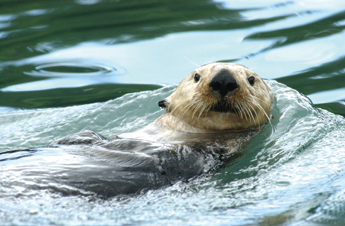
Sea otter in Simpson Bay, Prince William Sound, Alaska |
Sea otters and the nearshore ecosystems they inhabit—from highly urbanized California to relatively pristine Alaska—are the focus of a new multidisciplinary study by scientists with the U.S. Geological Survey (USGS) and a suite of international, academic and government collaborators. The Coastal Ecosystem Responses to Influences from Land and Sea project will investigate the many interacting variables that influence the health of coastal ecosystems along the Northeast Pacific shore. These ecosystems face unprecedented challenges, with threats arising from the adjacent oceans and lands. From the ocean, challenges include acidification, sea level rise, and warming. From the land, challenges include elevated biological, geological and chemical pollutants associated with burgeoning human populations along coastlines. The implications of these challenges for biological systems are only beginning to be explored. Comparing sea otter population status indicators from around the northeastern Pacific Rim, will begin the process of defining factors of coastal ecosystem health in this broad region. |
Changing Coastal Ecosystems
At the interface between oceans and continents, coastal ecosystems are shaped not only by processes unique to the nearshore environment, but also by influences from the neighboring ocean and land. Influences from the open ocean include currents that deliver nutrients (such as nitrogen and phosphorus) and food resources (such as phytoplankton—”primary producers” that convert inorganic material and sunlight into biomass—and zooplankton, which transfer that biomass to animals higher in the food web). Ocean influences also include factors that challenge the present-day equilibrium, such as ocean acidification, sea-level rise, and ocean warming. Coastal ecosystems receive freshwater, sediments, and additional nutrients from the land, which can impose challenges that include pollutants and pathogens associated with burgeoning human populations.
Northeast Pacific Sea Otter Populations
The sea otter is a small, furbearing mammal that feeds by diving to the sea floor for clams, crabs, urchins and other bottom dwelling species. Sea otters are in geographically separate populations that span more than 30 degrees of latitude and vary in status from gradually increasing to declining. In the sea otters’ food web, the primary producers are kelps (large seaweeds belonging to the class of brown algae), and food energy is transferred through benthic (bottom-dwelling) invertebrates, to high-level consumers, such as fishes, birds, and mammals. The sea otter is an apex predator (at the top of its food web) and a keystone species. The term “keystone” is adapted from architecture where an arch will collapse if the keystone is removed. Used in ecology, a keystone species is one which, if removed from its ecosystem, causes drastic changes in that ecosystem. Sea otters serve as a focal point for understanding the variables that influence their ecosystem because they integrate the combined effects of watersheds, oceans, and nearshore environment into their diet, behavior, condition, and health, that ultimately is reflected in their abundance and population trends over time. |
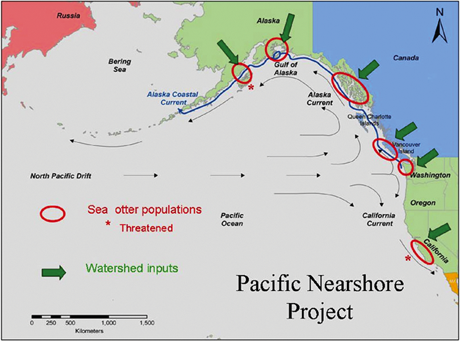 Geographic bounds and conceptual components of USGS Pacific nearshore-ecosystem study, including six geographically distinct sea otter populations (from west to east, Katmai, Prince William Sound, southeast Alaska, British Columbia, Washington, and California). |
Primary Factors Contributing to Sea Otter Abundance and Growth Rates
This study will contrast six geographically distinct sea otter populations, including two populations listed as “threatened” under the Endangered Species Act, to identify factors that contribute to variation in the animals’ density and abundance. The study design incorporates ecosystem productivity (oceanic and nearshore), watershed inputs, and sea otter diet and nutrition as primary factors potentially regulating population abundance and growth rates. Ecosystem productivity will be estimated by measuring annual growth rates of nearshore fishes and by analyzing remotely sensed data, including such data as ocean temperature and chlorophyll concentrations provided by satellite imagery, and air temperature and wind velocity provided by oceanographic stations. Human modifications of the watershed and terrestrial inputs into the nearshore will be estimated by analyzing remotely sensed data, including satellite imagery, as well as data collected by hydrographic stations (variables measured such as rainfall, streamflow, and certain chemical concentrations in watersheds). Sea otter diet and nutrition will be estimated through direct observation of foraging animals and analysis of stable isotopes obtained from their whiskers.
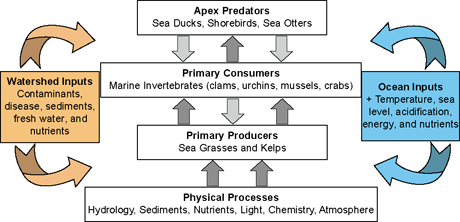 Simplified nearshore marine food web where kelps and sea grasses provide primary production and benthic invertebrates transfer energy to apex consumers. |
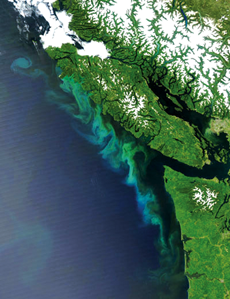
Phytoplankton bloom (water that looks turquoise) near the coast of Vancouver Island, British Columbia, Canada. |
Using Gene-Expression Technology to Evaluate Sea Otter Health
Concurrently, the researchers will use gene-expression technology to evaluate the health and condition of sea otters relative to the nearshore ecosystem. When a gene is “expressed” in response to stressful stimuli, it produces genetic material (messenger RNA, or mRNA) that instructs cells to produce proteins that combat the ill effects of the stimuli. Specific pollutants and pathogens are known to activate certain genes, and by identifying and quantifying the mRNA products, researchers can use gene expression in concert with clinical evaluation to diagnose an organism’s state of health relative to exposure to contaminants or diseases. As part of this project, blood samples collected from sea otters in each population will be analyzed for evidence of genes expressed by organic pollutants, metals, parasites, bacterial infection, viral infection, injury, and thermal stress. |
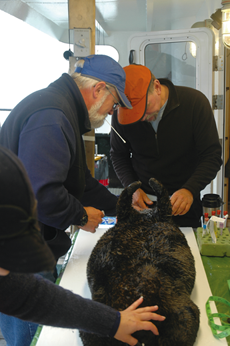 Veterinarian Mike Murray (Monterey Bay Aquarium; left) and Jim Bodkin (USGS) record a sedated sea otter’s vital signs and prepare to take a blood sample for gene-expression analysis, which will reveal information about the animal’s exposure to pollutants and disease.
|
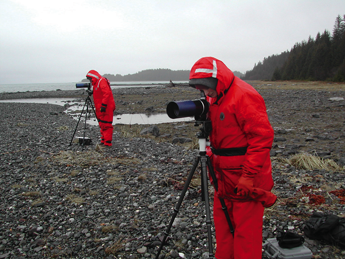
In 2006, George Esslinger (USGS; left) and Heather Coletti (National Park Service) used spotting scopes to observe sea otters in Glacier Bay, Alaska, and determine what they are eating.
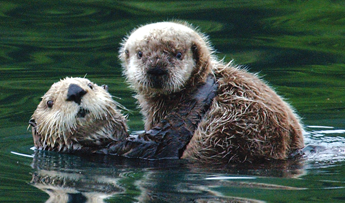
Sea otter mother and pup in Simpson Bay, Prince William Sound, Alaska.
|
Determining Present Status of Nearshore Ecosystem and Forecasting Future Changes
Researchers will analyze the nearshore and ocean productivity, watershed inputs, sea otter diet and nutrition, and sea otter gene expression data sets to determine the present status of each of the six sea otter populations and, by inference, the health and condition of their nearshore ecosystems. Data acquired in this study will inform and support future modeling efforts to forecast nearshore ecosystem responses to anticipated environmental change, such as increasing air and ocean temperatures, sea-level rise, ocean acidification, contaminants, and disease.
Partnering in Science
Key partners in this study include the USGS (Alaska Science Center, Western Fisheries Research Center, and the Western Ecological Research Center), U.S. Fish and Wildlife Service, National Park Service, Bureau of Ocean Energy Management, Regulation and Enforcement, Exxon Valdez Oil Spill Trustee Council, North Pacific Research Board, Fisheries and Oceans Canada, University of Wyoming, Washington Department of Fish and Wildlife, California Department of Fish and Game, Seattle Aquarium, and Monterey Bay Aquarium. |
|
First posted October 13, 2010
Part or all of this report is presented in Portable Document Format (PDF); the latest version of Adobe Reader or similar software is required to view it. Download the latest version of Adobe Reader, free of charge. |